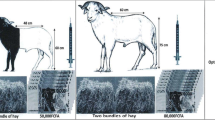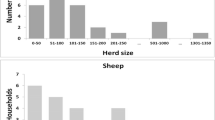Abstract
Sheep, recognised as one of the important livestock species especially in the semi-arid tropics with high genetic resource potentials, can be exploited through sustainable utilization in order to improve livestock keepers’ livelihoods. This study presents the evaluation of the economic values of sheep genetic resources (SGR) in terms of the important non-market traits embedded in sheep and how this information can be utilised to improve livelihoods in semi-arid regions. The results obtained from mixed logit models results derived from stated choice data collected from 157 respondents in the semi-arid Marsabit district of Kenya reveal that disease resistance is the most highly valued trait whose resultant increment results into a welfare improvement of up to KShs.1537. Drought tolerance and fat deposition traits were found to be implicitly valued at KShs.694 and 738 respectively. The results further point out that for livestock stakeholders to effectively improve the livelihoods of poor livestock-keepers, development strategies for improving the management and/or utilisation of SGR in terms of drought tolerance, should not only be tailor made to target regions that are frequently devastated by drought but should also succeed other strategies or efforts that would first lead to the improvement of producers’ economic status.


Similar content being viewed by others
Notes
A fixed parameter essentially treats the standard deviation as zero such that all the behavioural information is captured by the mean.
The percentages of populations were calculated using the following formula: \( {\text{Prob}}{\left( {b > 0} \right)} = {\text{Prob}}{\left( {Z > \frac{{ - mean}} {{std.dev}}} \right)} \) (also see Omondi (2007) for more elaborate exemplification).
Abbreviations
- AnGR:
-
animal genetic resources
- ASALs:
-
Arid and Semi-Arid lands
- CE:
-
choice experiment
- CP:
-
ceteris paribus
- GIS:
-
Geographic Information System
- MXL:
-
mixed logit
- SGR:
-
sheep genetic resources
References
Banzhaf, M. R., Johnson F. R., and Mathews K. E., 2001. Opt-out Alternatives and Anglers’ Stated Preferences. In: Bennett J. and Blamey R. (eds.) The Choice Modelling Approach to Environmental Valuation, (Edward Elgar Publishing, Cheltenham)
Bateman, I. J., Carson, R. T., Day, B., Hanemann, W. M., Hanley, N., Hett, T., Jones-Lee, M., Loomes, G., Mourato, S., Özdemiroğlu, E., Pearce, D. W., Sugden, R. and Swanson, S., 2003. Guidelines for the Use of Stated Preference Techniques for the Valuation of Preferences for Non-market Goods, (Edward Elgar Publishing, Cheltenham)
Devendra C., 2005. Small Ruminants in Asia; Contribution to Food Security, Poverty Alleviation and Opportunities for Productivity Enhancement. In: Proceedings International Workshop on Small Ruminant Production and Development in South East Asia Hanoi, Vietnam, 2–4 March 2005 http://www.mekarn.org/procsr/Devendra.pdf [accessed on 13/02/06]
Drucker, A.G., Gomez, V., Anderson, S., 2001. The Economic Valuation of Farm Animal Genetic Resources: A Survey of Available Methods. Ecological Economics, 36, 1–18
Freeman, A. M. (2003). The Measurement of Environmental and Resource Values: Theory and Methods. 2nd edition, (Resources for the Future, Washington D.C)
Gicheha, M. G., Kosgey, I.S., Bebe, B.O., and Kahi, A.K., 2006. Evaluation of the Efficiency of Alternative Two-Tier Nucleus Breeding Systems Designed to Improve Meat Sheep in Kenya. Journal of Animal Breeding and Genetics, 123, 247–257
GOK (Government of Kenya), 2002a. National Development Plan (NDP). 9th National Development Plan 2002–2008, (Ministry of Finance and Planning, Nairobi)
GOK (Government of Kenya), 2002b. Marsabit District Development Plan 2002–2008, (Ministry of Finance and Planning, Nairobi)
GOK (Government of Kenya), 1997. Marsabit District Development Plan 1997–2002, (Ministry of Finance and Planning, Nairobi)
Grandin B.E., Bekure S., Nestel P., 1991 Livestock transactions, food consumption and household budgets. In: S. Bekure, P.N. de Leeuw, B.E. Grandin, P.J.H. Neate (eds), Maasai Herding: An Analysis of the Livestock Production System of Maasai Pastoralists in Eastern Kajiado District, Kenya, Vol. 4. International Livestock Centre for Africa (ILCA) Systems Study, Addis Ababa, Ethiopia, pp. 103–114
Green, P. E., Srinivasan, V., 1978. Conjoint Analysis in Consumer Research: Issues and Outlook. The Journal of Consumer Research, 5, No. 2, 103–123
Greene, W. H., 2002. Nlogit Version 3.0 Reference Guide, (Econometric Software Inc., New York)
Hensher, D. A., Rose, J. M., and Greene, W. H., 2005. Applied Choice Analysis: A Primer, (Cambridge University Press, New York)
Jabbar, M. A., Diedhiou, M. L., 2003. Animal Genetic Resources and Economic Development: Issues in Relation to Economic valuation. Ecological Economics, 45, 461–472
Jaitner J., Sowe J., Secka-Njie E., Demple L., 2001. Ownership Pattern and Management Practices of Small Ruminants in The Gambia: Implications for a Breeding Programme. Small Ruminant Research, 40, 101–108
Kinyamario, J.I., Ekeya, W.N., 2001. Mechanisms of Drought Management by African Pastoralists. In: Proceedings of animal production society of Kenya symposium, 8–11 March, 2001, Egerton University, Kenya, 117–122
Kosgey, I. S., 2004. Breeding Objectives and Strategies for Small Ruminants in the Tropics. (Published PhD Thesis: Animal Breeding and Genetics Group, Wageningen University)
Kosgey I.S., van Arendonk J.A.M., Baker R.L., 2004. Economic Values for Traits in Breeding Objectives for Sheep in the Tropics: Impact of Tangible and Intangible Benefits. Livestock Production Science, 88, 143–160
Kuhfeld, W.F., 2003. Marketing Research Methods in SAS: Experimental Design, Choice, Conjoint, and Graphical Techniques (SAS Institute Inc., Cary NC, USA)
Landry, C. and Hindsley, P., 2007. Willingness To Pay For Risk Reduction and Amenities: Applications of the Hedonistic Price Method in the Coastal Zone. Working paper, The Center for Natural Hazards Research, East Carolina University, USA. http://www.ecu.edu/hazards/pdfs/working_papers/Landry_Hindsley.pdf [accessed on 28/05/07)
Lebbie, S. H. B., Ramsay, K., 1999. A Perspective on Conservation and Management of Small Ruminant Genetic Resources in the Sub-Saharan Africa. Small Ruminants Research, 34, 231–247
Louviere, J. J., Hensher, D. A., and Swait, J. D., 2000. Stated Choice Methods. (Cambridge University press, U.K)
Mackenzie J., 1993. A Comparison of Contingent Preference Models. American Journal of Agricultural Economics 65, 593–603
MLFD (Ministry of Livestock and Fisheries Development), 2003. Annual Report for the Year 2003 (MLFD, Nairobi)
Njanja, J. C., Gathuma, J. M., Gitau, G. K., Njeruh, F. M., Kinuthia, R. N., 2003. Pastoralists’ Perception of Livestock Production Systems and Opportunities for Improvement in Southwestern Marsabit, Kenya. Livestock Research for Rural Development, 15
Oluoch-Kosura, W., Ariga, E.S., Okeyo, A.M., Waithaka, M.M., And Kyalo, A.M., 1999. Agricultural Technology, Economic Viability and Poverty Alleviation in Kenya. In: Proceedings of the Workshops on Structural Transformation in Africa, June 27–30, 1999, Nairobi. http://www.Aec.Msu.Edu/Fs2/Ag_Transformation/Atw_Oluoch.pdf [Accessed On 31/05/07]
Omondi, I. A., 2007. Economic Analysis of Indigenous Small Ruminant Breeds in the Pastoral Production System: A Case of Sheep and Goat in Marsabit, Kenya. (Unpublished Msc. Thesis, Egerton University)
Ouma, E., Abdulai, A., and Drucker, A. 2007. Measuring Heterogeneous Preferences for Cattle Traits among Cattle-Keeping Households in East Africa. American Journal of Agricultural Economics 89, 1005–1019
Rege, J. E. O., Gibson, J. P., 2003. Animal Genetic Resources and Economic Development: Issues in Relation to Economic valuation. Ecological Economics, 45, 319–330
Ruto, E., Garrod, G. and Scarpa, R. 2008. Valuing Animal Genetic Resources: A Choice Modeling Application to Indigenous Cattle in Kenya. Agricultural Economics, 38, 89–98
Sadoulet, E., de Janvry, A., 1995. Quantitative Development Policy Analysis, (John Hopkins University Press, London)
Scarpa, R., Ruto, E. S. K., Kristjanson, P., Radeny, M., Drucker, A. G., Rege, J. E. O., 2003a. Valuing Indigenous Cattle Breeds in Kenya: An Empirical Comparison of Stated and Revealed Preference Value estimates. Ecological Economics, 45, 409–426
Scarpa, R., Drucker, A. G., Anderson, S., Ferraes-Ehuan, N., Gomez, V., Risopatron, C. R., Rubio-Leonel, O., 2003b. Valuing Genetic Resources in Peasant Economies: The Case of ‘Hairless’ Creole Pigs in Yucatan. Ecological Economics, 45, 427–443
Slingerland, M., van Rheenen, T., 2000. The Small Ruminant Sub-sector in Zoundwe’Ogo Province: Household Financing Restricts Remuneration of Animal Production. In: Slingerland, M. (Ed.), Mixed Farming: Scope and Constraints in West African Savanna. Tropical Resource Management Papers, 34, 91–105
Tablino, P., 1999. The Gabra: Camel Normads of Northern Kenya (Paulines Publications Africa, Bologna)
Tano, K., Kamuanga, M., Faminow, M. D., Swallow, B., 2003. Using Conjoint Analysis to estimate Farmer’s Preferences for Cattle Traits in West Africa. Ecological Economics, 45, 393–407
Upton, M., 1985. Returns from Small Ruminants Production in South West Nigeria. Agricultural Systems, 17, 65–83
Waithaka, M. M., Nyangaga, J. N., Staal, S. J., Wokabi, A. W., Njubi, D., Muriuki, K. G., Njoroge, L. N. and Wanjohi, P. N., 2002. Characterization of Dairy Systems in the Western Kenya Region. (Smallholder Dairy Project, Nairobi). http://www.smallholderdairy.org/collaborative%20res%20reports.htm [accessed on 15/07/06]
Wollny, C.B.A., 2003. The Need to Conserve Farm Animal Genetic Resources in Africa: Should Policy Makers be Concerned? Ecological Economics, 45, 341–351
Zander, K. K., 2006. Modelling the Value of Farm Animal Genetic Resources – Facilitating Priority Setting for the Conservation of Cattle in East Africa, (Unpublished PhD Dissertation, University of Bonn): http://hss.ulb.uni-bonn.de/diss_online/landw_fak/2006/zander_kerstin [accessed on 10/11/06]
Zander, K.K. and Drucker, A.G. In press. Conserving What’s Important: Using Choice Model Scenarios to Value Local Cattle Breeds in East Africa. Ecological Economics.
Zygoyiannis, D. (2006). Sheep Production in the World and in Greece. Small Ruminant Research, 62, 143–147
Acknowledgments
The authors gratefully acknowledge the financial assistance provided by the ILRI/BMZ (International Livestock Research Institute/German Ministry of Economic Cooperation) collaborative project based at ILRI, Nairobi. The contributions of Prof. Brigitte Kauffman, Dr. Eric Ruto, Dr. Samuel Mwakubo, Dr. Isaac S. Kosgey and Mr. Harun Warui are also greatly acknowledged as is the fieldwork logistical assistance provided by Messrs. Haro Guyo, Mamo Sora and Edward Leteror.
Author information
Authors and Affiliations
Corresponding author
Rights and permissions
About this article
Cite this article
Omondi, I., Baltenweck, I., Drucker, A.G. et al. Economic valuation of sheep genetic resources: implications for sustainable utilization in the Kenyan semi-arid tropics. Trop Anim Health Prod 40, 615–626 (2008). https://doi.org/10.1007/s11250-008-9140-7
Received:
Accepted:
Published:
Issue Date:
DOI: https://doi.org/10.1007/s11250-008-9140-7




